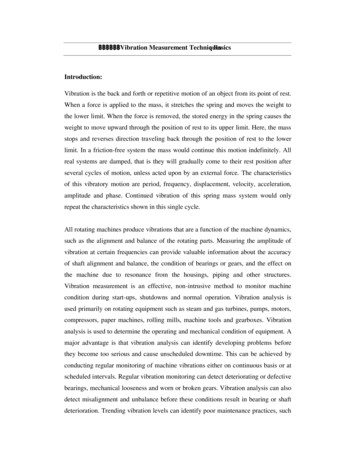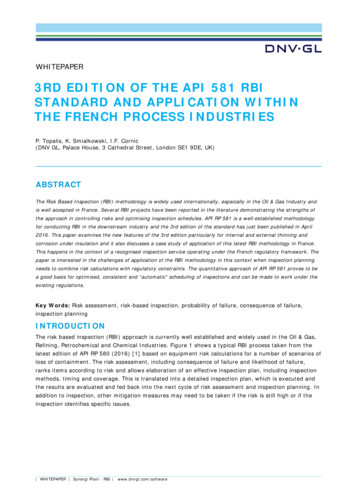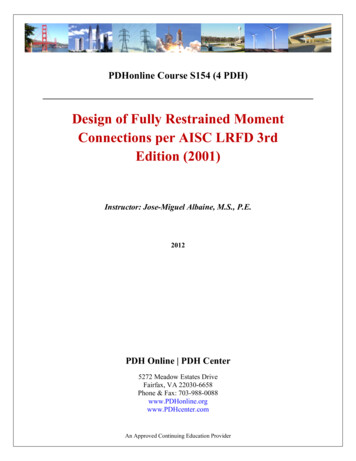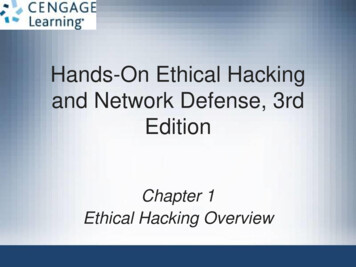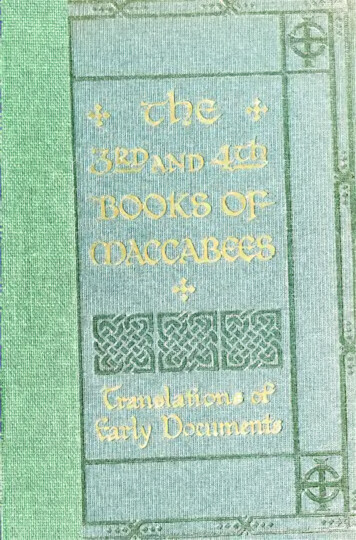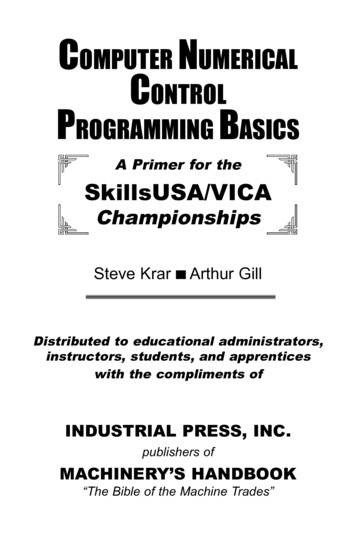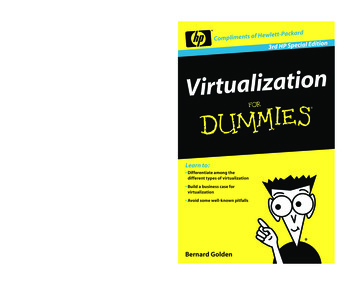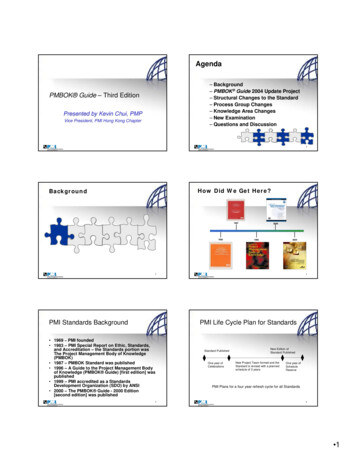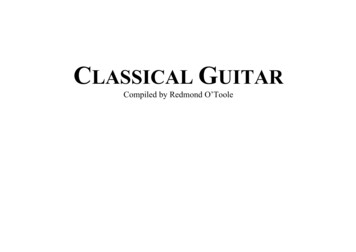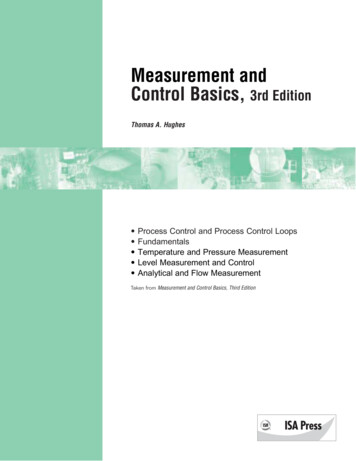
Transcription
Measurement andControl Basics, 3rd EditionThomas A. Hughes Process Control and Process Control LoopsFundamentalsTemperature and Pressure MeasurementLevel Measurement and ControlAnalytical and Flow MeasurementTaken from Measurement and Control Basics, Third Edition
NoticeThe information presented in this publication is for the general education of the reader. Because neither theauthors nor the publisher have any control over the use of the information by the reader, both the authors andthe publisher disclaim any and all liability of any kind arising out of such use. The reader is expected toexercise sound professional judgment in using any of the information presented in a particular application.Additionally, neither the authors nor the publisher have investigated or considered the effect of any patents onthe ability of the reader to use any of the information in a particular application. The reader is responsible forreviewing any possible patents that may affect any particular use of the information presented.Any references to commercial products in the work are cited as examples only. Neither the authors nor thepublisher endorse any referenced commercial product. Any trademarks or tradenames referenced belong to therespective owner of the mark or name. Neither the authors nor the publisher make any representation regardingthe availability of any referenced commercial product at any time. The manufacturer’s instructions on use ofany commercial product must be followed at all times, even if in conflict with the information in thispublication.Copyright 2002 ISA – The Instrumentation, Systems, and Automation SocietyAll rights reserved.Printed in the United States of America.10 9 8 7 6 5 4 3 2ISBN 1-55617-764-XNo part of this work may be reproduced, stored in a retrieval system, or transmitted in any form or by anymeans, electronic, mechanical, photocopying, recording or otherwise, without the prior written permission ofthe publisher.ISA67 Alexander DriveP.O. Box 12277Research Triangle Park, NC 27709Library of Congress Cataloging-in-Publication DataHughes, Thomas A.Measurement and control basics / Thomas A. Hughes.-- 3rd ed.p. cm. -- (Resources for measurement and control series)Includes bibliographical references and index.ISBN 1-55617-764-X1. Process control--Instruments. 2. Measuring instruments. I. Title.II. Series.TS156.8 .H78 2001670.42'7--dc212001006083
Editor’s IntroductionThis “mini-book” is available both in downloadable form, as part of the ISA Press Digital Book Library,and bound in a print format.“Mini-books” are small, unified volumes, from 25 to 100 pages long, drawn from the ISA catalog ofreference and technical books. ISA makes mini-books available to readers who need narrowly focusedinformation on particular subjects rather than a broad-ranging text that provides an overview of the entiresubject. Each provides the most recent version of the material—in some cases including revisions that havenot yet been incorporated in the larger parent volume. Each has been re-indexed and renumbered so it canbe used independently of the parent volume. Other mini-books on related subjects are available.The material in this mini-book was drawn from the following ISA titles: Measurement and Control Basics, 3rd Edition, by Thomas A. Hughes.Order Number: 1-55617-764-XTo order:Internet: www.isa.orgPhone: 919/549-8411Fax:919/549-8288Email: info@isa.org
ISA Resources for Measurement and Control Series (RMC)Measurement and Control Basics, 3rd Edition (2002)Industrial Level, Pressure, and Density Measurement (1995)Industrial Flow Measurement (1990)Programmable Controllers, 3rd Edition (2001)Control Systems Documentation: Applying Symbols and Identification (1993)Industrial Data Communications: Fundamentals and Applications,3rd Edition (2002) Real-Time Control Networks (1993) Automation Systems for Control and Data Acquisition (1992) Control Systems Safety Evaluation and Reliability, 2nd Edition(1998)
THIS BOOK IS DEDICATED TOmy wife Ellen, my daughter Audrey, and my mother Helenefor their love
CONTENTSABOUT THE AUTHORPREFACExiiixvChapter 1 INTRODUCTION TO PROCESS CONTROLIntroduction, 1Definition of Process Control, 1Elements of a Process Control System, 3General Requirements of a Control System, 7Intuitive Approach to Process Control Concepts, 9Chapter 2 PROCESS CONTROL LOOPSIntroduction, 27Single-loop Feedback Control, 27Time Elements of a Feedback Loop, 30Comparison of Basic Physical Systems, 35Dead Time Lag, 47Advanced Control Loops, 49Tuning Control Loops, 53127Chapter 3 ELECTRICAL AND ELECTRONIC FUNDAMENTALSIntroduction, 67Fundamentals of Electricity, 67Selecting Wire Size, 81Electrical Control Devices, 87Chapter 4 DIGITAL SYSTEM FUNDAMENTALSIntroduction, 93Binary Signals and Codes, 936793ix
xTable of ContentsNumbering Systems, 94Data Codes, 101Binary Logic Functions, 106Logic Function Symbols, 111Ladder Logic Diagrams, 111Chapter 5 PRESSURE MEASUREMENTIntroduction, 117Definition of Pressure, 117Manometers, 126Pressure Gauges, 128117Chapter 6 LEVEL MEASUREMENT AND CONTROLIntroduction, 147Sight-type Instruments, 147Pressure-type Instruments, 151Electrical-type Instruments, 155Sonic-type Instruments, 160Radiation-type Instruments, 161Level Switches, 165147Chapter 7 TEMPERATURE MEASUREMENT 171Introduction, 171A Brief History of Temperature Measurement, 171Temperature Scales, 172Reference Temperatures, 173Filled-System Thermometers, 175Bimetallic Thermometers, 176Thermocouples, 179Resistance Temperature Detectors, 188Thermistors, 193Integrated-Circuit Temperature Sensors, 195Radiation Pyrometers, 197Chapter 8 ANALYTICAL MEASUREMENT AND CONTROLIntroduction, 201Conductivity Measurement, 201Hydrogen-Ion Concentration (pH) Measurement, 204Density and Specific Gravity Measurement, 208Humidity Measurement, 216Principles of Electromagnetic Radiation, 221Electromagnetic Spectrum, 221Photodetectors, 224Turbidity Analyzer, 231Gas Analysis, 232Analyzer Measurement Applications, 236201
Table of ContentsChapter 9 FLOW MEASUREMENTIntroduction, 241Flow Principles, 241Flow-Measuring Techniques, 252xi241Chapter 10 FINAL CONTROL ELEMENTSIntroduction, 275Control Valve Basics, 275AC and DC Motors, 292Pumps, 302275Chapter 11 PROCESS CONTROL COMPUTERSIntroduction, 309History of Process Control Computers, 309Distributed Control Systems, 315Programmable Controllers, 318Basic Components of PLC Systems, 320Plantwide Computer-based System, 336309Appendix A STANDARD GRAPHICS SYMBOLS FOR PROCESS CONTROLAND INSTRUMENTATION 341Appendix B THERMOCOUPLE TABLES353Appendix C ANSWERS TO EXERCISES357INDEX367
ABOUT THE AUTHORThomas A. Hughes, a Senior Member of ISA—The Instrumentation, Systems, and Automation Society, has 30 years of experience in the designand installation of instrumentation and control systems, including 20years in the management of instrumentation and control projects for theprocess and nuclear industries. He is the author of two books: Measurement and Control Basics, 3rd Edition, (2002) and Programmable Controllers, 3rdEdition, (2001), both published by ISA.Mr. Hughes received a B. S. in engineering physics from the University ofColorado, and a M.S. in control systems engineering from Colorado StateUniversity. He holds professional engineering licenses in the states of Colorado and Alaska, and has held engineering and management positionswith Dow Chemical, Rockwell International, EG&G Rocky Flats, ToproSystems Integration, and the International Atomic Energy Agency. Mr.Hughes has taught numerous courses in electronics, mathematics, andinstrumentation systems at the college level and in industry. He is currently the Principal Consultant with Nova Systems Engineering Servicesin Arvada, Colorado.xiii
PrefaceThe third edition of Measurement and Control Basics is a thorough and comprehensive treatment of the basic principles of process control and measurement. It is designed for engineers, technicians, management, and salespersonnel who are new to process control and measurement. It is alsovaluable as a concise and easy-to-read reference source on the subject.This new edition provides expanded coverage of pressure, level, flow,temperature, analytical measurement, and process control computers.Material on the proper tuning of control loops was added to Chapter 1,and expanded coverage of control loops was added to Chapter 2. Chapter3 includes a more complete discussion of electrical and electronic fundamentals needed in process control and instrumentation.The discussion of the basic principles underlying pressure measurementhas been expanded to include a discussion of sensor characteristics andpotentiometric-type pressure sensors. Extensive coverage was added ontypical pressure transmitter applications. The discussion on level measurement has been increased with the addition of several common levelinstruments and switches such as displacers, tape floats, microwave, andradar. The chapter on temperature measurement has been improved byadding new illustrations and a section on radiation pyrometers. Coverageof analytical measurement and control in Chapter 8 was increased by theaddition of a section on the principles of electromagnetic radiation and itsapplication to analytical measurement. Three sections were also added toChapter 8 on photoconductive sensors, photomultiplier tubes, and turbidity analyzers.Chapter 9 on flow measurement contains new coverage on ReynoldsNumber and fluid flow profiles. The discussion of the basic principles ofxv
xviMeasurement and Control Basicsfluid flow has been expanded and improved in Chapter 9. A discussion ontypes of control valves and control valve actuators was added to Chapter10 and the section on control valve sizing was expanded and improved.All of the chapters have been supplemented with new or improved example problems and exercises. Most of the illustrations in the book have beenrevised and improved.
1Introduction toProcess ControlIntroductionTo study the subject of industrial process control effectively you must firstgain a general understanding of its basic principles. To present these control principles clearly and concisely, an intuitive approach to process control is used. First, however, some basic definitions and concepts of processcontrol are presented.Definition of Process ControlThe operations that are associated with process control have alwaysexisted in nature. Such “natural” process control can be defined as anyoperation that regulates some internal physical characteristic that isimportant to a living organism. Examples of natural regulation in humansinclude body temperature, blood pressure, and heart rate.Early humans found it necessary to regulate some of their external environmental parameters to maintain life. This regulation could be defined as“artificial process control” or more simply as “process control,” as we willrefer to it in this book. This type of process control is accomplished byobserving a parameter, comparing it to some desired value, and initiatinga control action to bring the parameter as close as possible to the desiredvalue. One of the first examples of such control was early man’s use of fireto maintain the temperature of their environment.The term automatic process control came into wide use when people learnedto adapt automatic regulatory procedures to manufacture products or pro-1
2Measurement and Control Basicscess material more efficiently. Such procedures are called automaticbecause no human (manual) intervention is required to regulate them.All process systems consist of three main factors or terms: the manipulated variables, disturbances, and the controlled variables (Figure 1-1).Typical manipulated variables are valve position, motor speed, damperposition, or blade pitch. The controlled variables are those conditions,such as temperature, level, position, pressure, pH, density, moisture content, weight, and speed, that must be maintained at some desired value.For each controlled variable there is an associated manipulated variable.The control system must adjust the manipulated variables so the desiredvalue or “set point” of the controlled variable is maintained despite ocessControlledVariablesFigure 1-1. Process control variablesDisturbances enter or affect the process and tend to drive the controlledvariables away from their desired value or set point condition. Typical disturbances include changes in ambient temperature, in demand for product, or in the supply of feed material. The control system must adjust themanipulated variable so the set point value of the controlled variable ismaintained despite the disturbances. If the set point is changed, themanipulated quantity must be changed to adjust the controlled variable toits new desired value.For each controlled variable the control system operators select a manipulated variable that can be paired with the controlled variable. Often thechoice is obvious, such as manipulating the flow of fuel to a home furnaceto control the temperature of the house. Sometimes the choice is not soobvious and can only be determined by someone who understands theprocess under control. The pairing of manipulated and controlled variables is performed as part of the process design.
Chapter 1 – Introduction to Process Control3Elements of a Process Control SystemFigure 1-2 illustrates the essential elements of a process control system. Inthe system shown, a level transmitter (LT), a level controller (LC), and acontrol valve (LV) are used to control the liquid level in a process tank. Thepurpose of this control system is to maintain the liquid level at some prescribed height (H) above the bottom of the tank. It is assumed that the rateof flow into the tank is random. The level transmitter is a device that measures the fluid level in the tank and converts it into a useful measurementsignal, which is sent to a level controller. The level controller evaluates themeasurement, compares it with a desired set point (SP), and produces aseries of corrective actions that are sent to the control valve. The valve controls the flow of fluid in the outlet pipe to maintain a level in the ntrollerLiquidControlValveFigure 1-2. Process level control: ExampleThus, a process control system consists of four essential elements: process,measurement, evaluation, and control. A block diagram of these elements isshown in Figure 1-3. The diagram also shows the disturbances that enteror affect the process. If there were no upsets to a process, there would beno need for the control system. Figure 1-3 also shows the input and outputof the process and the set point used for control.
4Measurement and Control BasicsSet tDisturbancesFigure 1-3. Four elements of a control systemProcessIn general, a process consists of an assembly of equipment and materialthat is related to some manufacturing operation or sequence. In the example presented in Figure 1-2, the process whose liquid level is placed undercontrol includes such components as a tank, the liquid in the tank, the flowof liquid into and out of the tank, and the inlet and outlet piping. Anygiven process can involve many dynamic variables, and it may be desirable to control all of them. In most cases, however, controlling only onevariable will be sufficient to control the process to within acceptable limits.One occasionally encounters a multivariable process in which many variables, some interrelated, require regulation.MeasurementTo control a dynamic variable in a process, you must have informationabout the entity or variable itself. This information is obtained by measuring the variable.Measurement refers to the conversion of the process variable into an analog or digital signal that can be used by the control system. The devicethat performs the initial measurement is called a sensor or instrument. Typical measurements are pressure, level, temperature, flow, position, andspeed. The result of any measurement is the conversion of a dynamic variable into some proportional information that is required by the other elements in the process control loop or sequence.EvaluationIn the evaluation step of the process control sequence, the measurementvalue is examined, compared with the desired value or set point, and theamount of corrective action needed to maintain proper control is deter-
Chapter 1 – Introduction to Process Control5mined. A device called a controller performs this evaluation. The controllercan be a pneumatic, electronic, or mechanical device mounted in a controlpanel or on the process equipment. It can also be part of a computer control system, in which case the control function is performed by software.ControlThe control element in a control loop is the device that exerts a direct influence on the process or manufacturing sequence. This final control elementaccepts an input from the controller and transforms it into some proportional operation that is performed on the process. In most cases, this finalcontrol element will be a control valve that adjusts the flow of fluid in aprocess. Devices such as electrical motors, pumps, and dampers are alsoused as control elements.Process and Instrumentation DrawingsIn the measurement and control field, a standard set of symbols is used toprepare drawings of control systems and processes. The symbols used inthese drawings are based on the standard ANSI/ISA-5.1-1984 (R1992)Instrumentation Symbols and Identification, which was developed byISA—The Instrumentation, Systems, and Automation Society (ISA) andthe American National Standards Institute (ANSI). A typical applicationfor this standard are process and instrumentation diagrams (P&IDs),which show the interconnection of the process equipment and the instrumentation used to control the process. A portion of a typical P&ID isshown in Figure 1-4.In standard P&IDs, the process flow lines, such as process fluid and steam,are indicated with heavier solid lines than the lines that are used to represent the instrument. The instrument signal lines use special markings toindicate whether the signal is pneumatic, electric, hydraulic, and so on.Table A-1 in appendix A lists the instrument line symbols that are used onP&IDs and other instrumentation and control drawings. In Figure 1-4, twotypes of instrument signals are used: double cross-hatched lines denotethe pneumatic signals to the steam control valve and the process outletflow control valve, and a dashed line is used for the electrical control linesbetween various instruments. In process control applications, pneumaticsignals are almost always 3 to 15 psig (i.e., pounds per square inch, gaugepressure), and the electric signals are normally 4 to 20 mA (milliamperes)DC (direct current).A balloon symbol with an enclosed letter and number code is used to represent the instrumentation associated with the process control loop. This
6Measurement and Control trolValveCondensateFigure 1-4. P&ID: Exampleletter and number combination is called an instrument identification orinstrument tag number.The first letter of the tag number is normally chosen so that it indicates themeasured variable of the control loop. In the sample P&ID shown in Figure 1-4, T is the first letter in the tag number that is used for the instruments in the temperature control loop. The succeeding letters are used torepresent a readout or passive function or an output function, or the lettercan be used as a modifier. For example, the balloon in Figure 1-4 markedTE represents a temperature element and that marked TIC is a temperature-indicating controller. The line across the center of the TIC balloonsymbol indicates that the controller is mounted on the front of a main control panel. No line indicates a field-mounted instrument, and two linesmeans that the instrument is mounted in a local or field-mounted panel.Dashed lines indicate that the instrument is mounted inside the panel.Normally, sequences of three- or four-digit numbers are used to identifyeach loop. In our process example (Figure 1-4), we used loop numbers 100and 101. Smaller processes use three-digit loop numbers; larger processesor complex manufacturing plants may require four or more digits to identify all the control loops.Special marks or graphics are used to represent process equipment andinstruments. For example, in our P&ID example in Figure 1-4 two parallel
Chapter 1 – Introduction to Process Control7lines represent the orifice plate that is used to detect the discharge flowfrom the process heater. The two control valves in the figure also use a special symbol. See appendix A for a more detailed discussion of the instrumentation and process symbols that are used on P&IDs.General Requirements of a Control SystemThe primary requirement of a control system is that it be reasonably stable.In other words, its speed of response must be fairly fast, and this responsemust show reasonable damping. A control system must also be able toreduce the system error to zero or to a value near zero.System ErrorThe system error is the difference between the value of the controlled variable set point and the value of the process variable maintained by the system. The system error is expressed in equation form by the following:e(t) PV(t) – SP(t)(1-1)wheree(t) PV(t) SP(t) system error as a function of time (t)the process variable as a function of timeis the set point as a function of timeSystem ResponseThe main purpose of a control loop is to maintain some dynamic processvariable (pressure, flow, temperature, level, etc.) at a prescribed operatingpoint or set point. System response is the ability of a control loop torecover from a disturbance that causes a change in the controlled processvariable.There are two general types of good response: underdamped (cyclicresponse) and damped. Figure 1-5 shows an underdamped or cyclicresponse of a system in which the process variable oscillates around theset point after a process disturbance. The wavy response line shown in thefigure represents an acceptable response if the process disturbance orchange in set point was large, but it would not be an acceptable response ifthe change from the set point was small.Figure 1-6 shows a damped response where the control system is able tobring the process variable back to the operating point with no oscillations.
8Measurement and Control BasicsPV (Process Variable)Set PointDisturbanceTimeFigure 1-5. Cyclic response to process disturbancePV (Process Variable)Set PointDisturbanceTimeFigure 1-6. Damped response to process disturbanceControl Loop Design CriteriaMany criteria are employed to evaluate the process control’s loop responseto an input change. The most common of these include settling time, maximum error, offset error, and error area (Figure 1-7).PV (Process Variable)Error AreasMax. ErrorOffsetErrorSet PointSettling TimeTimeFigure 1-7. Evaluation of control loop response
Chapter 1 – Introduction to Process Control9When there is a process disturbance or a change in set point, the settlingtime is defined as the time the process control loop needs to bring the process variable back to within an allowable error. The maximum error is simply the maximum allowable deviation of the dynamic variable. Mostcontrol loops have certain inherent linear and nonlinear qualities that prevent the system from returning the process variable to the set point after asystem change. This condition is generally called “offset error” and will bediscussed later in this chapter. The error area is defined as the area betweenthe response curve and the set point line as shown by the shaded area inFigure 1-7.These four evaluation criteria are general measures of control loop behavior that are used to determine the adequacy of the loop’s ability to performsome desired function. However, perhaps the best way to gain a clearunderstanding of process control is to take an intuitive approach.Intuitive Approach to Process Control ConceptsThe practice of process control arose long before the theory or analyticalmethods underlying it were developed. Processes and controllers weredesigned using empirical methods that were based on intuition (“feel”)and extensive process experience. Most of the reasoning involved wasnonmathematical. This approach was unscientific trial and error, but itwas a successful control method.Consider, for example, an operator looking into an early metal processingfurnace to determine whether the product was finished. He or she usedflame color, amount of smoke, and process time to make this judgment.From equally direct early methods evolved most of the control conceptsand hardware used today. Only later did theories and mathematical techniques emerge to explain how and why the systems responded as theydid.In this section, we will approach the study of control fundamentals inmuch the same way that control knowledge developed—that is, through astep-by-step procedure starting from manual control and moving to everincreasing automatic control.Suppose we have a process like that shown in Figure 1-8. A source of feedliquid flows into a tank at a varying rate from somewhere else in a processplant. This liquid must be heated so that it emerges at a desired temperature, Td, as a hot liquid. To accomplish this, hot water, which is availablefrom another part of the plant, flows through heat exchanger coils in thetank. By controlling the flow of hot water, we can obtain the desired tem-
10Measurement and Control Basicsperature, Td. A further process requirement is that the level of the tankmust neither overflow nor fall so low that it exposes the heater nkHotWaterFeedManualValveFigure 1-8. Example process – using manual valvesThe temperature is measured in the tank, and a temperature transmitter(TT-1) converts the signal into a 4-20 mA direct current (DC) signal todrive a temperature indicator (TI-1) mounted near the hot water inletvalve. Similarly, a level indicator (LI-2) is mounted within the operator'sview of the hot feed outlet valve (HV-2).Suppose a process operator has the task of holding the temperature, T,near the desired temperature, Td, while making sure the tank doesn't overflow or the level get too low. The question is how the operator would copewith this task over a period of time. He or she would manually adjust thehot water inlet valve (HV-1) to maintain the temperature and occasionallyadjust the outlet valve (HV-2) to maintain the correct level in the tank.The operator would face several problems, however. Both indicatorswould have to be within the operator's view, and the manual valveswould have to be close to the operator and easy to adjust.On/Off ControlTo make the operator's work easier, suppose we installed electrically operated solenoid valves in place of the manual valves, as shown in Figure 1-9.We can also install two hand switches (HS-1 and HS-2) so the solenoid
Chapter 1 – Introduction to Process Control11valves can be operated from a common location. The valves can assumetwo states, either fully open (on) or fully closed (off). This type of control iscalled two-position or on/off e 1-9. Sample process: Solenoid valvesAssume for the moment that the level is holding steady and that the mainconcern is controlling temperature. The operator has been told to keep thetemperature of the fluid in the tank at 100 F. He or she compares the reading of the temperature indicator with the selected set point of 100 F. Theoperator closes the hot water valve when the temperature of the fluid inthe tank rises above the set point (Figure 1-10). Because of process deadtime and lags the temperature will continue to rise before reversing andmoving toward the set point. When the temperature falls below 100 F, theoperator opens the hot water valve. Again, dead time and lags in the process create a delay before the temperature begins to rise. As it crosses theset point, the operator again shuts off the hot water, and the cycle repeats.This cycling is normal for a control system that uses on/off control. Thislimitation exists because its impossible for the operator to control the process exactly with only two options.This on/off type of control can be expressed mathematically as follows:e PV – SP(1-2)
12Measurement and Control BasicsProcess Variable (PV)Temperature Changes100oFSet Point (SP)Valve Position (V)OpenClosedFigure 1-10. “On/off” temperature controlwhereeSPPV the errorthe set pointthe process variableIn the on/off control mode, the valve is open valve when the error (e) ispositive ( ), and the valve is closed when e is negative (–).Proportional ControlWhen we view the process as a balance between energy in and energy out,it is clear that smoother control would result if a steady flow of hot waterwere maintained rather than the sudden changes between ON and OFF.The problem is finding the correct value for the steady flow required forproper control. Obviously, for each rate of feed flow in and out of the tank,some ideal amount of inlet water flow exists that will hold the outlet temperature, T, at 100 F.This suggests that we should make two modifications to our control modeor strategy. The first is to establish some steady-flow value for the hotwater that, at average operating conditions, tends to hold the process variable (temperature) at the desired value or set point (100 F). Once that average flow value has been established for the hot water, increases ordecreases of error (e SP – PV) must be allowed to cause correspondingincreases and decreases in water flow from this normal value.
and installation of instrumentation and control systems, including 20 years in the management of instrumentation and control projects for the process and nuclear industries. He is the author of two books: Measure-ment and Control Basics, 3 rd Edition, (2002) and Programmable


